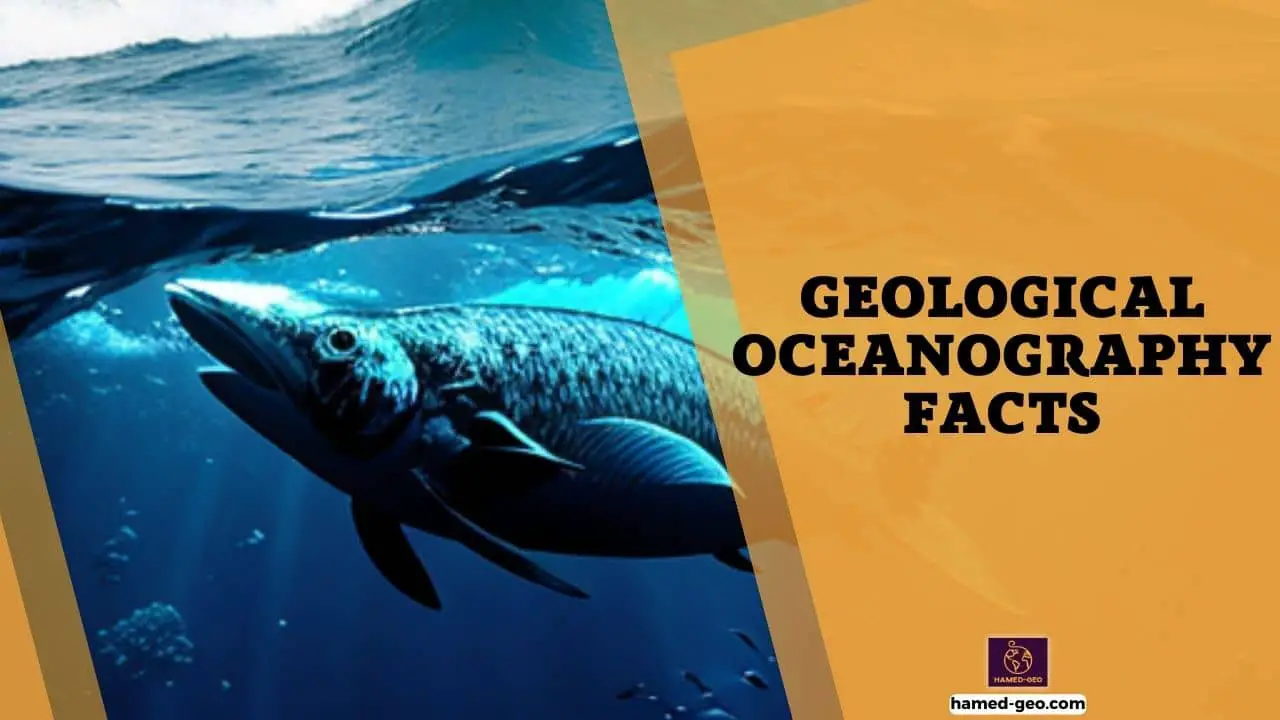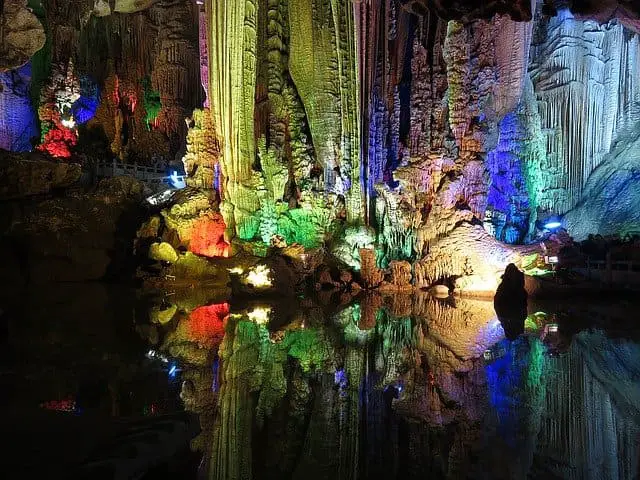The discipline of Geological Oceanography concerns the study of the ocean floor and its process. This branch of oceanography seeks to understand the geological structures and phenomena of the ocean basins, such as the formation of oceanic crust, the existence of underwater volcanoes, and the processes that lead to the creation of deep-sea trenches and mid-ocean ridges. It is a field that is vital in mapping the earth’s underwater topography and understanding geological processes that occur beneath the ocean surface.
Geological Oceanography significantly contributes to the knowledge and comprehension of climate change, as the ocean floor contains crucial evidence of the earth’s climatic history. Moreover, this discipline offers insights into the influences these geological features have on marine life and ecosystems. Its study also provides valuable information regarding natural resources, like oil and mineral deposits, offering economic potential for human societies.
The Earth’s Oceans
In understanding The Earth’s Oceans, begin with their Origin and Age, examining theories of their formation. Subsequently, assess the Distribution of Salinity and Temperature, noting their impacts on marine life and climate. Then, consider Sea Level Changes, reviewing implications for coastal regions. The vibrant Coral Reefs, indicative of ocean health, warrant an exploration, followed by the powerful and destructive Tsunami Phenomena. These subtopics together provide a comprehensive picture of the world’s oceans.
Origin and Age of the Oceans
Stepping into the world of water bodies, let’s delve into the origin and age of the oceans.
Earth’s oceans, a treasure trove of life and resources, originated about 4.4 billion years ago. Evidence suggests that water – the essential element for oceans – may have been delivered by icy comets or formed in Earth’s mantle and released through volcanic activity. New findings indicate that the world’s oceans are older than the Sun, contradicting previous beliefs.
These oceans have been evolving ever since their inception, with changes in their depth, volume, and geographical distribution. Unraveling the mysteries of their origin and age offers valuable insight into Earth’s geological past and the evolution of life.
Distribution of Salinity and Temperature
Drifting away from the origins and age of the oceans, the Distribution of Salinity and Temperature captures our attention. It is pertinent to understand that these factors significantly influence oceanic life and global climate. The average salinity of seawater is approximately 35 ppt (parts per thousand), yet it varies in different oceanic regions due to factors such as evaporation, precipitation, and river inflow. Similarly, ocean temperature distribution exhibits both latitudinal and depth variations, with surface temperatures ranging from -2°C to 30°C. Furthermore, it is the interplay of salinity and temperature that determines seawater density, thereby affecting oceanic currents and global climate patterns. This subtle balance, the very lifeblood of the ocean, demands acknowledgment and understanding.
Plate Tectonics
The study of Plate Tectonics involves understanding the Formation of Ocean Basins, formed primarily due to the movement and interaction of tectonic plates. This leads to a discussion of Major Plate Boundaries, where the plates meet and interact, often resulting in seismic and volcanic activity. These areas of Distribution of Volcanic and Seismic Activity are crucial to predicting natural disasters. Volcanic Activity itself is a subtopic that delves into the mechanisms of eruptions and their impact on the environment. Lastly, Tectonic Plate Maps provide a visual representation of these plates and their interaction points.
Formation of the Ocean Basins

Having discussed the Earth’s oceans, now let’s delve into understanding their formation. The formation of ocean basins involves an intricate geological process. Believe it or not, these basins are formed primarily as a result of plate tectonics. This process involves the movement and interaction of the Earth’s lithospheric plates. When these plates diverge or move apart, molten rock or magma from the mantle rises and solidifies, creating a new oceanic crust. Interestingly, mid-ocean ridges, which represent such divergent plate boundaries, are the sites of the youngest oceanic crust, contributing to the formation and expansion of the ocean basins.
Major Plate Boundaries
Transitioning from the vast expanse of Earth’s oceans, let’s delve into the underlying forces shaping these water bodies: plate tectonics. One critical aspect to understand: major plate boundaries. Three primary types exist: divergent, convergent, and transform. Divergent boundaries occur when two plates move apart, often resulting in seafloor spreading. Convergent boundaries are formed when two plates move towards each other, leading to subduction or mountain building. Lastly, transform boundaries are where plates slide past each other horizontally. These boundaries are often the sites of significant seismic activity. Accurate knowledge of these boundaries assists in predicting geological events and understanding the Earth’s historical geology.
Distribution of Volcanic and Seismic Activity
Now, imagine this: The very same forces that formed the vast ocean basins also govern the distribution of volcanic and seismic activity. The Earth’s crust, fragmented into tectonic plates, is in a constant state of motion. Where these plates interact, we witness a significant concentration of seismic and volcanic events. This is no mere speculation. Statistics reveal that about 90% of all earthquakes and 81% of the world’s largest volcanoes are located along the so-called Ring of Fire, a major area in the basin of the Pacific Ocean. Thus, it becomes evident that the dialogue between oceanic and tectonic forces shapes not only the face of our planet but also its seemingly restless nature.
Marine Sediments
Marine sediments originate from various sources and exhibit diverse types. The process of sedimentation is crucial in understanding how these sediments deposit under different conditions. These are further analyzed in specific sedimentary environments. Studying marine sediment core analysis provides insights into the physical properties, biological activity, and historical record of ocean chemistry. Lastly, deep sea sediments reveal significant information about the Earth’s past climate, biogeochemical cycles, and plate tectonics. This comprehensive examination of marine sediments aids in understanding the oceanic processes and their profound impact on the global climate system.
Sources and Types of Sediments
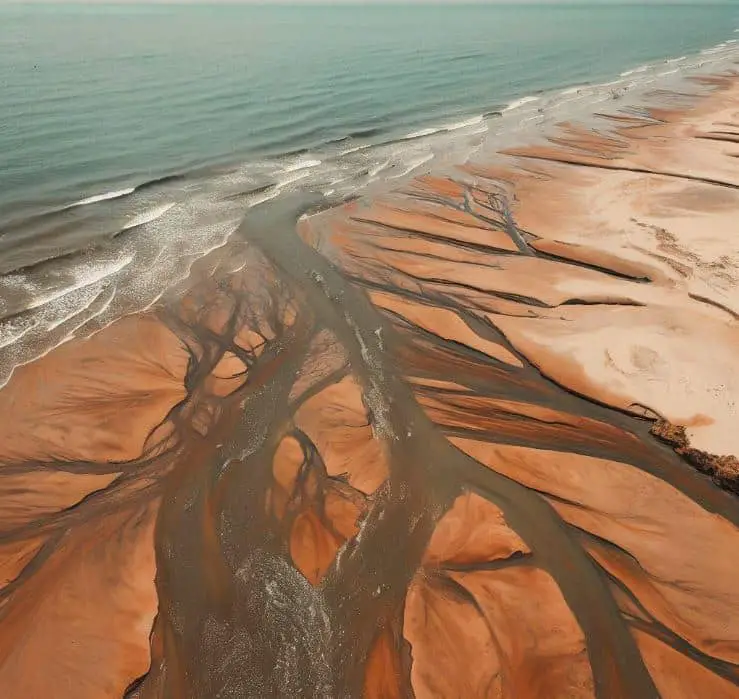
Shifting focus from the grandeur of plate tectonics, let’s delve into the fascinating world of marine sediments. Sources and Types of Sediments comprise an integral part of the marine environment. They originate from various sources, including terrestrial, biogenic, and cosmogenic, and are classified into four main types: terrigenous, biogenous, hydrogenous, and cosmogenous sediments. For instance, Terrigenous sediments, the most abundant type, are derived from land and delivered to the ocean via rivers, wind, and glaciers. Conversely, Biogenous sediments are composed of the remains of marine organisms.
Process of Sedimentation
Imagine, for a moment, the vast expanse of the ocean floor, a hidden universe of diverse and complex ecosystems. But what if that unique environment was to shift, transformed by the passage of time and the relentless process of sedimentation? This process, central to the formation and preservation of marine ecosystems, is driven by the continuous deposition of particles, typically eroded from land and transported by rivers to the sea. The size, composition, and rate of these deposits are influenced by numerous factors, including ocean currents, climate, and human activities. Crucially, these factors not only determine the characteristics of marine sediments but also shape the distribution and diversity of habitats in the deep sea.
Sedimentary Environments
As we dig deeper into the oceanic realm, it’s essential to explore the fascinating world of sedimentary environments. These environments, where sediments are deposited, play a pivotal role in shaping the ocean floor. They can be broadly classified into three types: continental, transitional, and marine. Continental environments include lakes and deserts, while transitional environments refer to beach and lagoon settings. Marine environments, on the other hand, cover the deep ocean basins. The type of sediment and the processes of deposition vary significantly across these environments, dictated by factors such as wave action, water temperature, and biological activity. These differences create a diverse mosaic of sedimentary environments, each with its unique geologic story to tell.
Marine Structures
In studying marine structures, the focus extends to Seamounts and Abyssal Hills, underwater mountains, and hills that contribute significantly to ocean biodiversity. This is followed by an exploration of Mid-Ocean Ridges and Submarine Canyons, the world’s largest mountain ranges and deep-sea fissures. The study further encompasses Fracture Zones and Transform Faults, crucial for our understanding of plate tectonics. Abyssal Plains, the flattest regions on Earth, is also noteworthy.
Seamounts and Abyssal Hills
From the intriguing world of marine sediments, let’s dive deeper into the awe-inspiring formations beneath the ocean’s surface. Welcome to the realm of seamounts and abyssal hills. Seamounts, underwater mountains rising over 1,000 meters above the ocean floor, create a remarkable topographical feature. Abyssal hills, on the other hand, are less dramatic but more common, covering large swathes of the seafloor. Fascinatingly, these formations are not merely geological features; they also host a rich diversity of marine life, creating unique ecosystems. The interaction between these underwater structures and their biological communities is a captivating area of ongoing research.
Mid-Ocean Ridges and Submarine Canyons
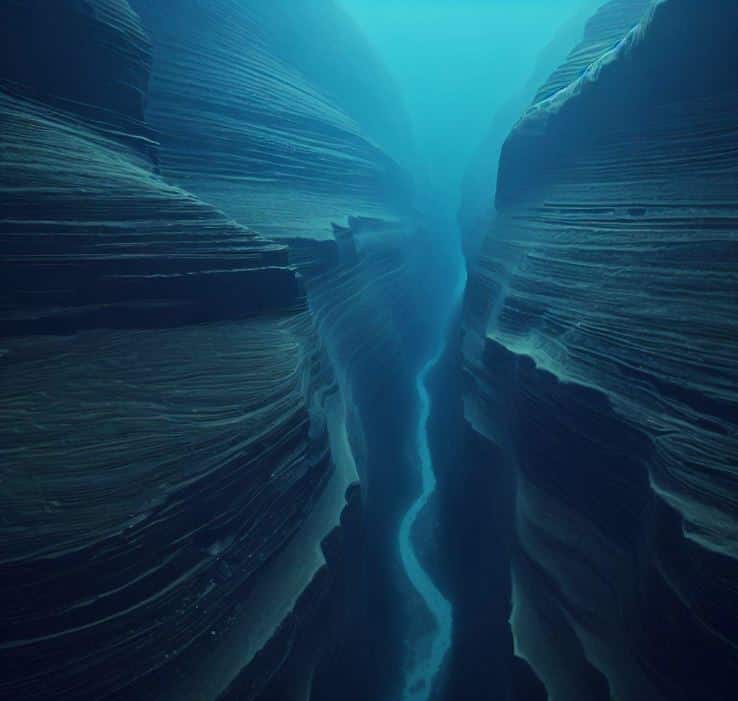
With the ocean floor blanketed in a rich tapestry of sediments, imagine the wonders that lie below. A striking feature of the ocean floor includes Mid-Ocean Ridges and Submarine Canyons. Mid-Ocean Ridges, spanning over 65,000 kilometers worldwide, are submerged mountain ranges formed by plate tectonics. They are the sites where new oceanic crust is created through volcanic activity. On the other hand, Submarine Canyons, similar to their land counterparts, are steep-sided valleys cut into the seabed. They serve as pathways for sediment transported from the continental shelf to the deep sea, playing a crucial role in marine sedimentation. Both of these structures contribute to the complex and dynamic nature of the marine environment.
Fracture Zones and Transform Faults
Imagine a massive jigsaw puzzle, its jagged edges interlocking and sliding against one another. This is the reality beneath the ocean’s surface. Now, delve into the intricacies of the fracture zones and transform faults.
Fracture zones are extensive linear features, often thousands of kilometers long, characterized by an offset in the mid-ocean ridges. These zones are scars left by the movement of tectonic plates. Transform faults, on the other hand, are the active sections of a fracture zone, where the plates slide past each other. These faults are crucial in accommodating the varying rates of seafloor spreading on either side of a mid-ocean ridge. These geological structures play an integral role in the dynamics of Earth’s lithosphere.
Marine Resources
Marine resources, a vital aspect of Earth’s ecosystem, are categorized into several types, including mineral resources such as oil and gas, and biological resources like fish and algae. The discussion further unravels renewable resources, which replenish naturally over time and are environmentally sustainable. The mainstay of the discussion then shifts toward the types of marine resources, varying from food to energy sources. Finally, the discourse emphasizes the significant economic value of marine resources, highlighting their contribution to global economies.
Mineral Resources
While the grandeur of marine structures captures the imagination, the true wealth of the oceans lies beneath their surface. The first category of marine resources is mineral resources. These encompass a broad range of elements, from precious metals like gold and silver to other valuable substances such as oil and natural gas. It is estimated that the seabed holds approximately 10 billion tons of gold alone. Additionally, marine mineral resources include polymetallic nodules and rare-earth elements, which are vital for modern technology. The extraction and utilization of these mineral resources contribute significantly to the global economy, making the seas a veritable trove of untapped wealth. This underscores the economic potential of the marine environment and the importance of sustainable extraction methods.
Biological Resources

Shifting focus from man-made marine structures, the ocean’s natural wealth presents a vast array of Biological Resources. These resources, which include various species of fish, crustaceans, mollusks, and seaweeds, provide essential nutrients and substances that foster human health and well-being. For instance, fish and shellfish are appreciated for their high protein content and are necessary in many cultures’ diets. Beyond this, a significant proportion of pharmaceuticals are derived from marine organisms, highlighting their medicinal value. Also, seaweeds are increasingly used in food, cosmetic, and industrial applications, underlining their versatility. Notably, sustainable management of these biological resources is critical to ensure their longevity and the continued ability to reap their benefits.
Renewable Resources
Moving away from the robustness of marine structures, let’s dive into the potential of the ocean’s renewable resources. Renewable resources are those that can be replenished naturally over time, such as wind, wave, and solar energy. Ocean thermal energy conversion (OTEC), which utilizes the temperature difference between cooler deep and warmer shallow seawater to run a heat engine and produce electricity, is an excellent example of marine renewable energy. Furthermore, tidal energy, generated by the gravitational effects of the moon and the sun on the Earth, has significant potential for future electricity generation. These renewable resources not only have immense potential to meet global energy requirements but also help mitigate climate change by reducing reliance on fossil fuels.
Oceanic Earthquakes and Volcanism
To evaluate Oceanic Earthquakes and Volcanism, comprehension of various associated phenomena is required. Initially, it is crucial to understand different Types of Earthquakes and their oceanic implications. Concurrently, the study of Volcanic Eruptions in the marine context is vital. Subsequently, the ensuing Tsunamis and Tidal Waves must be analyzed. The underpinning theory of Plate Tectonics provides a framework for these occurrences. Lastly, the concept of Seafloor Spreading is essential, showing how new oceanic crust is formed through volcanism and moved by earthquakes.
Types of Earthquakes
Just as the ocean’s depths hide a bounty of resources, they also conceal a potent force of nature: earthquakes. With that in mind, let’s dive into the types of oceanic earthquakes. There are three main types: tectonic, volcanic, and collapse earthquakes. Tectonic earthquakes, the most common type, occur when the earth’s crust breaks due to geological forces on rocks and adjoining plates. Then there are volcanic earthquakes, which result from tectonic forces occurring in conjunction with volcanic activity. Lastly, collapse earthquakes are small quakes in underground caverns and mines. Each type presents unique challenges to marine scientists studying seismic activity beneath the waves.
Volcanic Eruptions
Diving deeper into marine resources, the ocean floor holds other significant phenomena, such as volcanic eruptions. These underwater eruptions create new seafloor and contribute to the growth of volcanic islands. There are three main types of volcanic eruptions: explosive, effusive, and phreatomagmatic. Explosive eruptions occur when gases trapped in magma cause a violent explosion, often leading to the formation of volcanic ash. On the other hand, effusive eruptions involve the steady flow of lava onto the ocean floor. Lastly, phreatomagmatic eruptions happen when magma comes into contact with water, causing a steam-driven explosion. These various types of eruptions play a crucial role in shaping underwater topography and influencing marine ecosystems.
Tsunamis and Tidal Waves
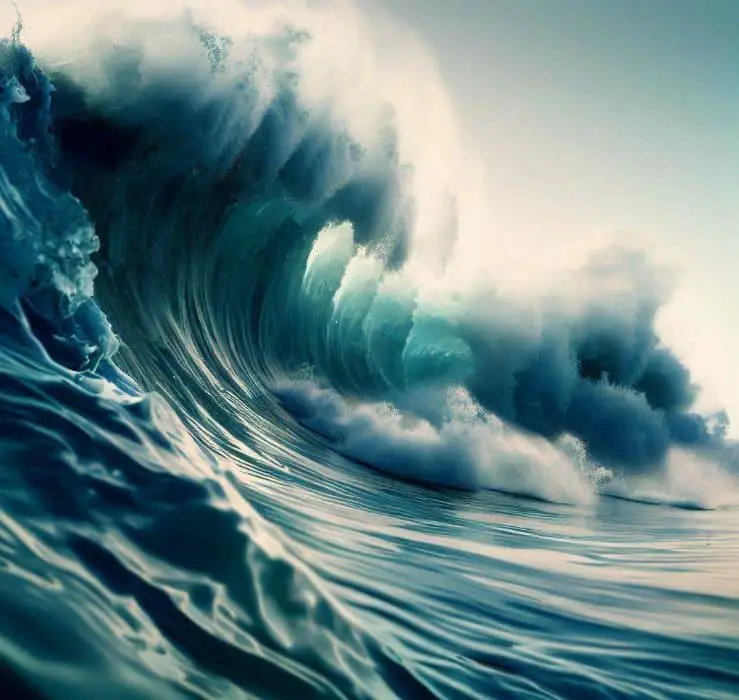
While marine resources hold immense value, it’s impossible to ignore the potent forces of nature that shape the oceanic environment. One such force is the occurrence of tsunamis and tidal waves. Tsunamis, large ocean waves caused by underwater earthquakes or volcanic eruptions, can cause catastrophic damage when they reach coastal areas. Tidal waves, on the other hand, are long-period waves caused by the gravitational interactions between the Earth, moon, and sun. Although less destructive than tsunamis, tidal waves still significantly influence the oceanic landscape and marine life. Both phenomena illustrate the immense and sometimes destructive power of oceanic forces.
Marine Chemistry
In studying Marine Chemistry, it is necessary to explore several key areas. Major Constituents of Seawater represent the fundamental chemical components of the world’s oceans. Understanding the Carbon Cycle is crucial for examining the role of oceans in climate change. The Formation of the Oceanic Crust involves geochemical processes significant to the chemical composition of seawater. Chemical Oceanography Techniques offer methods for analyzing marine chemical phenomena. Lastly, Marine Inorganic Chemistry focuses on the behavior of inorganic substances in marine environments. Each of these subtopics significantly contributes to the comprehensive understanding of marine chemistry.
Major Constituents of Seawater
Transitioning from the turbulence of oceanic earthquakes and volcanism, let’s dive into the calm yet complex world of marine chemistry. Starting with the major constituents of seawater, an understanding of its constituents can shed light on the complex processes that occur beneath the ocean’s surface. Seawater is not merely water; it is a solution of numerous substances. It primarily contains dissolved salts, with sodium and chloride ions making up about 85% of these salts. Other significant constituents include magnesium, calcium, potassium ions, and traces of elements like iodine, iron, and zinc. These constituents not only dictate the salinity of the ocean but also influence its pH, density, and freezing point. A thorough understanding of these constituents forms the basis of marine chemistry and its subsequent topics.
Carbon Cycle
Having explored the tumultuous world of oceanic earthquakes and volcanism, it’s now crucial to shift focus to another equally important aspect: the ocean’s chemical makeup. Notably, the carbon cycle plays a pivotal role in marine chemistry. The ocean is both a sink and a source of carbon dioxide. As the largest active carbon pool, the ocean absorbs approximately one-fourth of anthropogenic CO2 emissions. A large part of this carbon is stored in the deep sea and sediments as inorganic carbon, while the rest is converted by photosynthetic marine organisms into organic carbon. The intricate processes of absorption, conversion, and storage constitute a vital component of the global carbon cycle.
Formation of the Oceanic Crust
Moving beyond the dramatic undersea events, let’s delve into the very genesis of the ocean floor. The formation of the oceanic crust is a fascinating process, driven by plate tectonics, a theory that explains the large-scale motions of Earth’s lithosphere. It occurs primarily at mid-ocean ridges, where new oceanic crust is formed through volcanic activity and then gradually moves away from the ridge. This process is known as seafloor spreading. The newly formed crust predominantly consists of basalt, a type of igneous rock. Further understanding of this process not only elucidates the dynamic nature of Earth’s crust but also implicates profound effects on global geochemical cycles.
Marine Life
Marine life is a vast subject that encompasses various subtopics. Marine Organisms, which are the lifeblood of the ocean, form complex Marine Ecosystems. These ecosystems rely on intricate Food Chains and Food Webs for sustenance and survival. Unfortunately, these delicate systems face increasing threats due to Ocean Pollution Impact, which is causing significant disruption in marine life. Lastly, Coastal Life provides a unique perspective, where land and sea life coexist, further emphasizing the interconnectedness of all marine life.
Marine Organisms
Diving deeper into the waters, one encounters the vast diversity of marine organisms. These organisms, varying from microscopic phytoplankton to mammoth whales, contribute significantly to marine biodiversity. Comprising over 200,000 species, they play crucial roles in maintaining the health of marine ecosystems. For instance, phytoplankton and seaweed produce about half of the world’s oxygen through photosynthesis. Furthermore, marine organisms form the basis of marine food chains and food webs, directly influencing the survival of other species. However, human-induced ocean pollution poses a severe threat to these organisms, often leading to their decline. In the next section, the intricate dynamics of marine ecosystems will be explored.
Marine Ecosystems
Swapping the test tubes for a telescope, let’s dive into the expansive world of marine ecosystems. These dynamic systems, teeming with an array of organisms, play a critical role in the biosphere. Marine ecosystems not only constitute about 71% of the Earth’s surface, but they also house approximately 50% of the world’s species. The diversity of life is astonishing, from the smallest plankton to the largest whales. Interestingly, these ecosystems are categorized based on their depth and the living organisms present, such as the neritic zone, oceanic zone, and benthic zone. Each zone exhibits its distinctive characteristics and biodiversity, thus demonstrating the intricate balance of life beneath the ocean’s surface.
Food Chains and Food Webs
Diving deeper into the realm of marine life, one cannot overlook the intricacies of food chains and food webs. Complex and intricate, these systems form the backbone of life in the ocean. For instance, the marine food chain begins with phytoplankton, tiny plants that convert sunlight into energy through photosynthesis. Next in line are zooplankton, small animals like krill, which feed on the phytoplankton. Larger predators, in turn, consume these creatures, culminating with the apex predators such as sharks. Alternatively, food webs illustrate the interconnection of multiple food chains, showing the intricate balance of the ocean ecosystem. Understanding these systems is crucial, not only for marine biologists but for all stewards of the planet.
Deep-Sea Hydrothermal Vents

Deep-sea hydrothermal vents possess unique characteristics, including extreme temperatures and chemically rich waters. These vents support biological communities known for astounding biodiversity. The role of hydrothermal vents is pivotal in the ocean, contributing to primary productivity and nutrient cycling. Vents, classified as black and white smokers based on emitted particles’ color, harbor distinct microbial communities. Furthermore, vent-associated geothermal energy presents a promising renewable energy source due to the immense heat produced by these underwater geysers.
Unique Characteristics of Hydrothermal Vents
Venturing deeper into the fascinating realm of marine life, let’s delve into the unique characteristics of deep-sea hydrothermal vents. These geological formations, a consequence of underwater volcanic activity, provide an intriguing counterpoint to the more familiar, sunlight-drenched marine environments. Hydrothermal vents, often situated more than 2000 meters below sea level, emit mineral-rich, superheated seawater that can reach temperatures of over 400°C. Despite the extreme conditions, they support a myriad of life forms, a testament to the tenacity of nature. Remarkably, these vents are not uniform but can be classified into black and white smokers, based on the color and mineral content of the plumes they emit.
Biological Communities Found at Vents
Delving deeper into the ocean’s depths, one encounters a realm that is teeming with life despite the harsh conditions – the hydrothermal vents. Astoundingly, these vents host rich biological communities that thrive in extreme temperatures, high pressure, and complete darkness. Among the most remarkable inhabitants are chemosynthetic bacteria, which form the base of the food chain by converting chemicals from the vent fluids into energy. These bacteria support a wide array of organisms such as giant tube worms, vent shrimps, mussels, and a variety of unique fish species. This ecosystem, independent of sunlight and photosynthesis, is a testament to life’s adaptability and resilience. It is, indeed, a showcase of biological marvels that defies the traditional understanding of life’s requirements.
Role of Hydrothermal Vents in the Ocean
As we delve deeper into the ocean, the role of hydrothermal vents in the marine ecosystem becomes increasingly clear. These underwater hot springs play a vital role in the ocean’s chemical and thermal dynamics. They act as natural furnaces, heating the surrounding water and creating unique thermal gradients. Additionally, these vents are responsible for the release of significant amounts of minerals into the ocean, including iron, manganese, and copper. This mineral-rich water, in turn, supports diverse and dense biological communities. Thus, hydrothermal vents contribute to biogeochemical cycling in the ocean, influencing the distribution of nutrients and overall marine productivity. Through these processes, hydrothermal vents act as key drivers of the ocean’s health and biodiversity.
Ocean Pollution
Examining Ocean Pollution requires a comprehensive understanding of its various aspects. Firstly, the Sources of Pollution need identification, followed by a discussion on the Effects of Pollution on marine life and ecosystems. Next, it is crucial to explore the Strategies for Reducing Pollution to mitigate the damage. Two significant pollution types – Oil Spills and Toxic Metals – deserve special attention due to their devastating impact.
Sources of Pollution
Shifting focus from the natural wonders of the ocean, imagine the vast expanse of water tainted by human activities. Sources of Pollution in the ocean are predominantly anthropogenic, generated by both land and sea-based activities. Industrial waste, agricultural runoff, and marine dumping contribute to a significant proportion of marine pollution. Land-based sources account for approximately 80% of the world’s marine pollution, with plastics and other litter comprising a substantial part. Shipping activities also contribute to pollution through the accidental or deliberate release of oil and chemicals. Uncontrolled exploitation of resources, mismanaged waste disposal, and inadequate regulatory measures exacerbate the current situation. This alarming scenario serves as a wake-up call for urgent action.
Effects of Pollution
As we journey from the abyssal depths and hydrothermal vents to the surface, a distressing sight awaits the harsh reality of ocean pollution. The effects of pollution are devastating and far-reaching, impacting both marine and human life. Microplastics, for instance, have infiltrated every level of the food chain, posing threats to marine organisms and potentially to humans consuming seafood. Eutrophication, an excessive growth of algae due to nutrient pollution, results in oxygen-depleted zones where marine life cannot survive. Additionally, the introduction of pollutants affects biodiversity, leading to the loss of species and disruption of ecosystem balance. Understanding these repercussions is crucial for establishing effective strategies for pollution reduction.
Strategies for Reducing Pollution
Transitioning from the life-sustaining mysteries of deep-sea hydrothermal vents, it becomes more disheartening to contemplate the human-induced perils facing our oceans. Strategies for Reducing Pollution become a vital area of focus. Regulation and enforcement of waste discharge into the oceans by industries could significantly mitigate the pollution problem. The promotion of recycling and proper waste management practices among individuals and businesses curbs the amount of waste that ends up in the ocean. Technological innovations that filter out pollutants before releasing waste into the sea, and clean-up initiatives for existing pollution, are other effective strategies. Additionally, public awareness campaigns about the detrimental effects of ocean pollution could prompt behavioral changes that minimize pollution.
Oceanic Currents
This paper aims to explore the complex subject of Oceanic Currents. Initially, the different types of Oceanic Currents will be delineated, followed by an in-depth discussion on the Causes of Oceanic Currents. The focus will then shift toward the significant role these currents play in Marine Life. The modern-day Technology in Studying Ocean Currents will also be touched upon, showcasing the latest advancements in this field. Lastly, an insight into the Future of Ocean Current Research will be provided, shedding light on potential technological advancements and research directions.
Types of Oceanic Currents
Shifting our focus from the geology of the ocean floor, it is crucial to delve into the fascinating world of oceanic currents. These are essentially the circulation system of our oceans, enabling the movement of water across vast distances. Broadly classified into two categories, surface currents, and deep water currents, these differ markedly in their depth, temperature, and causes. Surface currents, constituting approximately 10% of all oceanic water, are primarily wind-driven and exist in the uppermost 400 meters of the ocean. Conversely, deep water currents, also known as thermohaline currents, account for the remaining 90%, moving slowly in the deep ocean influenced by differences in temperature and salinity.
Causes of Oceanic Currents
Having delved into the intriguing world of ocean floor geology, one might wonder, “What’s next?” Indeed, the answer lies in the realm of oceanic currents. These dynamic forces of the sea not only shape the geography beneath but also exert profound influences on the global climate and marine life.
Causes of Oceanic Currents are primarily influenced by the wind, the Earth’s rotation, and temperature and salinity differences. Wind-driven currents, such as the North Atlantic Drift, are typically horizontal and occur mainly at the ocean’s surface. Conversely, thermohaline currents are deep-water currents caused by variations in water density, which is affected by salinity and temperature.
Oceanography Technology
In the realm of Oceanography Technology, several innovative tools are instrumental. Remote Sensing enables the acquisition of ocean data without physical contact, proving crucial for large-scale observations. Similarly, Submersibles offer a direct yet controlled interaction with the marine environment. The advent of Deep-sea Exploration Technology has facilitated unprecedented access to the ocean’s darkest depths. Marine Geophysics Technology plays a pivotal role in understanding the ocean floor’s structural dynamics. Lastly, Oceanographic Software harnesses computational prowess to analyze data, model scenarios, and predict trends, furthering the understanding of this diverse field.
Remote Sensing
As the dance of oceanic currents shapes our global climate, so too does the technology used to study these currents shape our understanding of them. The field of Remote Sensing is a key player in this exploration. Remote sensing refers to the use of satellite or aircraft-based sensor technologies to detect and classify objects on Earth. It has drastically improved the collection of oceanographic data, facilitating real-time monitoring of the ocean’s physical and biological properties. For example, satellite images now provide information on sea surface temperatures, ocean color, and wave heights, all of which help in predicting weather patterns.
Submersibles
Moving away from the swirling dynamics of oceanic currents, let’s dive deeper into the mysteries of the ocean. Submersibles, both manned and unmanned, have transformed our understanding of the ocean’s depths. These underwater vehicles, such as the Alvin and the Jason, are equipped with high-powered lights and cameras to capture previously unseen details of underwater landscapes and creatures. The ROV Jason, for instance, has been used extensively in deep-sea explorations, mapping out the ocean floor, studying hydrothermal vents, and even assisting in the recovery of sunken artifacts. Submersibles are indeed a testament to the advancements in oceanography technology, enabling us to explore and understand the vast, uncharted territories of the ocean.
In summary, the field of geological oceanography provides crucial insights into the Earth’s oceans, their structures, and the myriad resources they offer. The understanding of marine sediments, plate tectonics, oceanic earthquakes, and volcanism helps to unlock the secrets of the ocean floor and the processes that shape it.
These revelations, complemented by the study of marine chemistry, marine life, and deep-sea hydrothermal vents, provide a comprehensive perspective on the oceanic ecosystem. The advancements in oceanography technology have greatly bolstered these studies. Nevertheless, the threat of ocean pollution underscores the urgent need for sustainable practices and conservation efforts.
